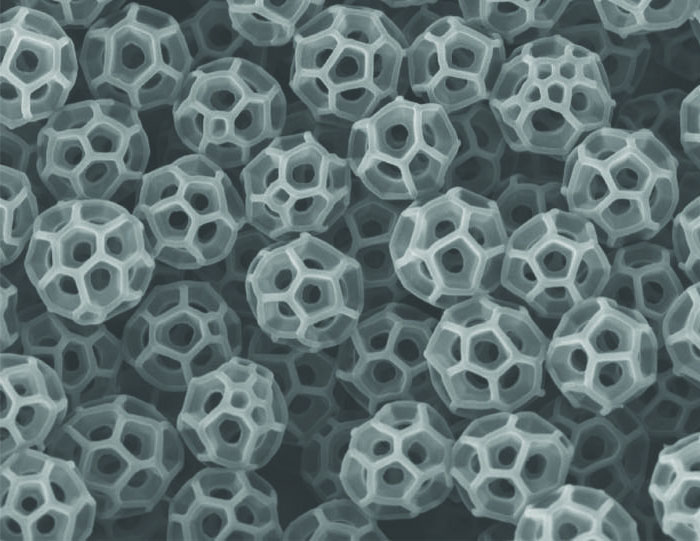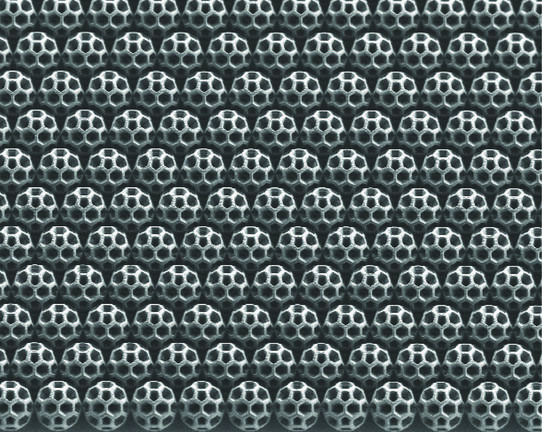[ad_1]
Mar 18, 2024
(Nanowerk Information) Leafhoppers, a standard yard insect, secrete and coat themselves in tiny mysterious particles that would present each the inspiration and the directions for next-generation expertise, in keeping with a brand new examine led by Penn State researchers. In a primary, the workforce exactly replicated the complicated geometry of those particles, referred to as brochosomes, and elucidated a greater understanding of how they soak up each seen and ultraviolet mild. Brochosomes are hole, nanoscopic, buckyball formed spheroids with through-holes distributed throughout leafhoppers’ physique surfaces.
This might permit the event of bioinspired optical supplies with doable purposes starting from invisible cloaking units to coatings to extra effectively harvest photo voltaic power, stated Tak-Sing Wong, professor of mechanical engineering and biomedical engineering. Wong led the examine, which was printed within the Proceedings of the Nationwide Academy of Sciences (“Geometric design of antireflective leafhopper brochosomes”).

Pictured are brochosomes produced by leafhopper G. serpenta. Brochosomes are hole, nanoscopic, buckyball-shaped spheroids with through-holes distributed throughout leafhoppers’ physique surfaces. Lin Wang et al. studied the connection between the optical properties and the geometric designs of the brochosomes. The authors discovered that the through-holes of those hole buckyballs play an necessary position in lowering the reflection of sunshine. That is the primary organic instance exhibiting brief wavelength, low-pass antireflection performance enabled by through-holes and hole constructions. (Picture: Lin Wang and Tak-Sing Wong, Penn State)
The distinctive, tiny particles have an uncommon soccer ball-like geometry with cavities, and their actual objective for the bugs has been one thing of a thriller to scientists for the reason that Nineteen Fifties. In 2017, Wong led the Penn State analysis workforce that was the primary to create a fundamental, artificial model of brochosomes in an effort to raised perceive their operate.
“This discovery may very well be very helpful for technological innovation,” stated Lin Wang, postdoctoral scholar in mechanical engineering and the lead creator of the examine. “With a brand new technique to control mild reflection on a floor, we would be capable to disguise the thermal signatures of people or machines. Maybe sometime folks might develop a thermal invisibility cloak based mostly on the methods utilized by leafhoppers. Our work exhibits how understanding nature will help us develop trendy applied sciences.”
Wang went on to elucidate that though scientists have identified about brochosome particles for three-quarters of a century, making them in a lab has been a problem because of the complexity of the particle’s geometry.
“It has been unclear why the leafhoppers produce particles with such complicated constructions,” Wang stated, “We managed to make these brochosomes utilizing a high-tech 3D-printing methodology within the lab. We discovered that these lab-made particles can cut back mild reflection by as much as 94%. It is a massive discovery as a result of it is the primary time we have seen nature do one thing like this, the place it controls mild in such a selected means utilizing hole particles.”
Theories on why leafhoppers coat themselves with a brochosome armor have ranged from conserving them freed from contaminants and water to a superhero-like invisibility cloak. Nonetheless, a brand new understanding of their geometry raises a powerful risk that its essential objective may very well be the cloak to keep away from predators, in keeping with Tak-Sing Wong, professor of mechanical engineering and biomedical engineering and corresponding creator of the examine.
The researchers have discovered that the dimensions of the holes within the brochosome that give it a hole, soccer ball-like look is extraordinarily necessary. The scale is constant throughout leafhopper species, regardless of the dimensions of the insect’s physique. The brochosomes are roughly 600 nanometers in diameter — about half the dimensions of a single bacterium — and the brochosome pores are round 200 nanometers.

Pictured is an array of 3D printed microscale artificial brochosome. In nature, leafhoppers produce brochosomes to coat their physique surfaces, that are hole, nanoscopic, buckyball-shaped spheroids with through-holes distributed throughout their surfaces. Lin Wang et al. studied the connection between the optical properties and the geometric designs of the brochosomes using 3D printed artificial brochosomes. The authors discovered that the through-holes of those hole buckyballs play an necessary position in lowering the reflection of sunshine. That is the primary organic instance exhibiting brief wavelength, low-pass antireflection performance enabled by through-holes and hole constructions.
“That makes us ask a query,” Wong stated. “Why this consistency? What’s the secret of getting brochosomes of about 600 nanometers with about 200-nanometer pores? Does that serve some objective?”
The researchers discovered the distinctive design of brochosomes serves a twin objective — absorbing ultraviolet (UV) mild, which reduces visibility to predators with UV imaginative and prescient, similar to birds and reptiles, and scattering seen mild, creating an anti-reflective defend towards potential threats. The scale of the holes is ideal for absorbing mild on the ultraviolet frequency.
This doubtlessly might result in quite a lot of purposes for people utilizing artificial brochosomes, similar to extra environment friendly photo voltaic power harvesting programs, coatings that shield prescription drugs from light-induced injury, superior sunscreens for higher pores and skin safety towards solar injury and even cloaking units, researchers stated. To check this, the workforce first needed to make artificial brochosomes, a significant problem in and of itself.
Of their 2017 examine, the researchers mimicked some options of brochosomes, significantly the dimples and their distribution, utilizing artificial supplies. This allowed them to start understanding the optical properties. Nonetheless, they had been solely in a position to make one thing that regarded like brochosomes, not a precise duplicate.
“That is the primary time we’re in a position to make the precise geometry of the pure brochosome,” Wong stated, explaining that the researchers had been in a position to create scaled artificial replicas of the brochosome constructions through the use of superior 3D-printing expertise.
They printed a scaled-up model that was 20,000 nanometers in dimension, or roughly one-fifth the diameter of a human hair. The researchers exactly replicated the form and morphology, in addition to the quantity and placement of pores utilizing 3D printing, to supply still-small fake brochosomes that had been giant sufficient to characterize optically.
They used a Micro-Fourier rework infrared (FTIR) spectrometer to look at how the brochosomes interacted with infrared mild of various wavelengths, serving to the researchers perceive how the constructions manipulate the sunshine.
Subsequent, the researchers stated they plan to enhance the artificial brochosome fabrication to allow manufacturing at a scale nearer to the dimensions of pure brochosomes. They can even discover further purposes for artificial brochosomes, similar to data encryption, the place brochosome-like constructions may very well be used as a part of an encryption system the place knowledge is just seen below sure mild wavelengths.
Wang famous that their brochosome work demonstrates the worth of a biomimetic analysis method, the place scientists seems to nature for inspiration.
“Nature has been trainer for scientists to develop novel superior supplies,” Wang stated. “On this examine, we’ve simply centered on one insect species, however there are lots of extra wonderful bugs on the market which can be ready for materials scientists to check, and they are able to assist us clear up varied engineering issues. They aren’t simply bugs; they’re inspirations.”
[ad_2]
Supply hyperlink




